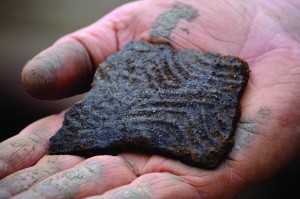
PHOTO: theonefeather.com
GAINESVILLE, GEORGIA – Archaeologists have discovered a rare 400-year-old Native American homestead site that belonged to a tribe who were the ancestors for what we now know as the Cherokee people.
The Cherokee were not documented by any English explorers until AD 1670. The first contact with Spanish explorers years earlier, in 1540, left Native American populations devastated by foreign illnesses. All expansion ceased. But this new site, carbon-dated to AD 1600-1615, approximately sixty or seventy years older than any of our information about the Cherokee people, has revealed new insights into how the members of the tribe lived their daily lives.
The site was home to an extended family of Native Americans living during the 1600s. Last year, the archaeologists and volunteers working on the site in Gainesville confirmed the location of a square house, about 600 square feet large, with a well-developed center hearth, indicating that the family had lived in the area for some time.
There were other finds at the site, including beautiful broken pottery with coils and swirls artfully etched into the clay. Archaeologists have found the remains of a clay wall, and charred wood as well. There’s more than 1,000 pottery shards on site and several stone tools, and test pits have been dug to look for any other buildings. It’s an extremely important find. With it, researchers hope to uncover the story of what happened at the family home and answer their questions. Further research will tell whether or not the family were farmers and what, exactly, drew them into the valley away from other Native American tribes. Warfare? Disease? Or something else?
The site is now in it’s third year of excavation. Local volunteers work side-by-side with researchers and archaeologists from the Chattahoochee-Oconee National Forest in Georgia. Time will tell whether or not any more of this 400-year-old family’s story will reveal itself.
“The value of this site is not in the artifacts themselves — those have little monetary value..rather like a page in a book, each artifact is valuable because it helps tell the full story of what happened here — our story, the human story.” – James Wettstead, Chattahoochee-Oconee National Forests archaeologist.

